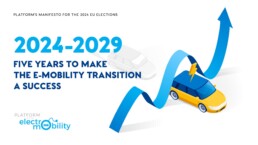Open letter
Accelerating the electrification of fleets is key to cut transport emissions and increase affordable electric vehicles for consumers
To European Commission Executive Vice-President for the European Green Deal,
To the European Commissioner for Climate Action,
To the European Commissioner for Transport,
Maroš Šefčovič
Adina-Ioana Vălean
Wopke Hoekstra
Dear,
First of all, we would like to congratulate Mr Šefčovič and Mr Hoekstra with their appointment respectively as Executive Vice-President for European Green Deal, Interinstitutional Relations and Foresight and Commissioner for Climate Action. We look forward to working together with you and supporting you during the upcoming mandate.
EU action to accelerate fleet electrification represents a golden opportunity to not only tackle transport emissions, EU’s largest source of greenhouse gas emissions, but also widen the access to cheaper second-hand electric vehicles. We therefore very much welcome Vice-President Šefčovič’s pledge during last week’s hearing that “By the end of the year, the Commission will launch a public consultation in preparation for future action to accelerate the electrification of corporate fleets by 2030.”
6 out of 10 cars sold in the EU are company cars, with those vehicles driving twice as much as private cars. The purchasing decisions of corporate fleets have far wider implications than just for that enterprise. Company cars tend to spend 3 to 5 years in a fleet before going into the used car market. With 8 out of 10 Europeans buying their cars in the used car market, this is a crucial channel for EU citizens.
Accelerating the transition towards electric vehicles beyond existing policies is a necessity to achieve transport’s net-zero and the 2040 climate target of -90%. As such, the faster fleets electrify their company cars, the faster more households will be able to access more affordable electric vehicles powered by clean European electricity, the faster we can reduce transport emissions. This is a win-win for climate and consumers.
Corporate fleets are in a great position to lead the way on electrification, with many already committed to fully transitioning their fleets by the end of the decade through Climate Group’s EV100 campaign. On a total cost of ownership basis, electric vehicles have the advantage over polluting vehicles meaning electrification makes strong business sense too. A regulatory framework would simply ensure that all fleets are playing their part.
That’s why the Platform for electromobility – the alliance of uniting automotive industries, NGOs, civil society and cities, the Europe’s leading consumer association and the leading global initiative bringing together fleets committed to electrification – are uniting and calling on you to:
- Deliver on your promise to launch a public consultation by the end of this year at the very latest.
- Limit the scope of the public consultation to legislative options to accelerate fleets electrification of at least 95% by 2030.
- Include light commercial vehicles in the scope of this public consultation.
- As part of this consultation come forward with a timeline for a swift adoption of this legislation.
We hereby reiterate that we fully support the European Commission in setting binding zero emission purchase targets for corporate fleet (passenger cars) of minimum 65% in 2027 and 95% in 2030 and binding electrification targets for light commercial vehicles.
We would very much appreciate a meeting where we can discuss this initiative. We count on your leadership to bring forward a public consultation.
With kind regards,

13th October 2023
2024 Election Manifesto
PLATFORM’S MANIFESTO FOR THE 2024 EU ELECTIONS
2024-2029: Five Years to make the e-mobility transition a Success
The agreement to pursue zero emissions for Europe’s new cars and vans by 2035 backed up by strong charging infrastructure and development of alternatives such as rail network, and the sustainable batteries regulation, has set a clear direction and an unequivocal target for sustainable transport measures.
However, in order to make the Green transition a reality, and bring its benefits to people, the planet and business, it is vital that we act now. Making the transition to e-mobility must be a priority, not simply to deliver environmental sustainability but also to reinforce the EU’s industrial strength, security and competitiveness.
Time to put the Green Deal into action
● The support of the legislative efforts and ambitions of the EU Green Deal and notably The agreement to pursue zero emissions for Europe’s new cars and vans.
● Now it is time to implement those ambitions to reduce Europe’s dependency of fossil fuels, make it a global leader in the sustainable transport industries and priorities quality of life and workspace for Europeans.
● An effective green industrial policy will bring the benefits of Europe’s Green Deal to all.

1st Pillar
A Green and Just Industrial Policy
● Creating an integrated recycling industry ecosystem in Europe.
● Smartening and upgrading existing grid infrastructure to allow it to support greater levels of renewable energy.
● Ensuring strong end-of-life vehicles regulation, focused on low carbon and recycled materials.
2nd Pillar
Investment Plan to implement the Green Deal
● Making it easier for green energy transition sectors to access current EU funding mechanisms.
● Deploying infrastructures to support zero-emission passenger and freight transport across Europe.
● Introducing a dedicated budget for urban nodes, to avoid cities becoming a weak link.


3rd Pillar
People at the heart of the e-mobility ecosystem
● Supporting reskilling programmes to attract workers from traditional industrial sectors and aiding their transition into these emerging sectors.
● Enabling Vehicle-to-Grid (V2G).
● Mandating electric vehicle adoption in corporate fleets.
"It’s time to look ahead and see how the next legislative mandate can put the Green Deal into action. The agreement to pursue zero emissions for Europe’s new cars by 2035 has set a clear direction but this trajectory now needs to be implemented right."
— Julia Poliscanova, Vice-Chair Platform for electromobility
[Video] Peter Badik (GreenWay) on Electricity Market Design
Electricity Market Design
Peter Badik, CEO of GreenWay, on the importance of the reform of the Electricity Market Design.
The Platform for electromobility, uniting industries, civil society organisations and cities from the transport, energy and clean tech sector, welcomes the Electricity Market Reform (EMD) proposal as an important opportunity to support the build-out of grid-friendly e-mobility across Europe. We appreciate the proposals improve the existing electricity market framework in a way that facilitates cost-effective deployment of individual or aggregated smart and bidirectional electric vehicles (EVs) charging. As the EV market is growing rapidly, smart and bidirectional charging will quickly become one of the most important sources of demand-side flexibility. In the collective European effort to decrease fossil gas imports, EV charging flexibility will be instrumental to reduce consumer costs, greenhouse gas emissions and better integrate solar and wind in the grid. Importantly, by offering additional revenues or cost saving opportunities to EV owners, the reform accelerates EV take-up and the clean transport transition.
The Platform therefore urges co-legislators to keep the level of ambition and a swift adoption. The European Commission’s EMD reform proposal supports the uptake of e-mobility in the following ways:
The reform recognises EVs as flexibility resource
Member States will have to make a detailed assessment of the needs and the potential of demand-side response and storage. Based on the assessment, an indicative objective shall be set and supportive measures, such as a flexibility support scheme, may be introduced. It is important to properly include EVs as a source of demand response and storage in both the assessment of the flexibility needs and the objective for demand response and storage, and ensure appropriate participation of EV stakeholders in these assessments processes.
The reform further supports the participation of EVs in the markets
The threshold for participation in the day ahead and intraday markets get lowered to 100 kW, which makes them more accessible to aggregations of EV fleets. This will help develop the market for user-centric smart and bidirectional charging services. It may be advisable to extend this lower threshold also to capacity markets.
The reform accelerates planning for EV charging infrastructure
Transmission and distribution system operators will be financially incentivized to fully consider local demand side resources, such as EVs, when looking for solutions for grid congestion. System operators will propose further transparency and proactivity on their planning for connecting EV charging infrastructure, for example by sharing hosting capacity available for EV charging. This is essential information for providers of EV charging services and helps accelerate grid-efficient build-out of EV charging infrastructure.
Greening Corporate Fleets Initiative: support to the launch of a public consultation
The Platform for electromobility supports the launch of a public consultation on the Greening Corporate Fleets Initiative .
The members of the Platform for electromobility, a leading advocate for sustainable mobility and environmental development, hereby publicly expresses their strong support for the Greening Corporate Fleets Initiative included in the European Commission’s work program for 2023 and called for by the European Parliament in May 2022.
We understand that it will be difficult to launch and complete this initiative before the end of the Commission’s mandate in 2024. We would however very positively welcome the launch of a public consultation on this very important topic to collect as much data and information to guarantee the success of such an initiative at a later date.
The Greening Corporate Fleets Initiative represents a vital step toward accelerating the transition to electric mobility, ensuring a sustainable future for both our environment and society. By calling for a comprehensive framework for corporate fleet emissions reduction, this initiative aligns with our previous policy recommendations on the matter (the reasons, the concerns and the methods). We firmly believe that it presents an excellent opportunity to drive meaningful change while safeguarding the interests of the most modest individuals who should not bear the sole burden of the transition.
The environmental benefits of the Greening Corporate Fleets Initiative cannot be overstated. By incentivizing and supporting the adoption of electric vehicles across corporate fleets which are now electrifying slower than private vehicles[1], we can significantly reduce greenhouse gas emissions and limit the impacts of transportation on our climate. This aligns with the ambitious climate targets set forth in the European Green Deal.
Furthermore, the social aspect of this initiative should not be overlooked. By focusing on corporate fleets, the Greening Corporate Fleets Initiative ensures a fair distribution of the costs associated with the transition to greener mobility solutions. As stated above, by shouldering a portion of the burden, corporations can contribute to building a more sustainable future while least-well-off families are not unduly burdened by the costs of this transition.
Moreover, the initiative’s emphasis on creating a robust second-hand market for electric vehicles is commendable. A thriving secondary market for EVs will not only enhance the affordability of these vehicles but also encourage the wider adoption of clean transport solutions. By stimulating the circular economy, this initiative will unlock significant economic and environmental benefits.
In conclusion, the Platform supports the Greening Corporate Fleets Initiative and encourages DG MOVE to promptly initiate a public consultation on this crucial matter. We believe that by working collaboratively, policymakers, industry stakeholders, and citizens can co-create a sustainable mobility landscape that fosters environmental stewardship, social equity, and economic growth.
[1] https://www.transportenvironment.org/wp-content/uploads/2023/05/Briefing-on-Fleets-Regulation-3.pdf
Weights & Dimensions Directive: ACEA, Platform for electromobility and Hydrogen Europe call it a priority in a joint letter
Open letter
Calling co-legislators for swift progress on the revision of the Weight and Dimensions Directive
To European Commission Executive Vice-President for the European Green Deal, Frans Timmermans
To the European Commissioner for Transport, Adina-Ioana Vălean
To Ambassador and Permanent Representative of Spain to the European Union, D. Marcos Alonso Alonso
To the Presidents of the TRAN and ENVI Committees of the European Parliament, Karima Delli and Pascal Canfin
To the Presidents of the European Parliament Political Groups,
Dear,
We, the undersigned representatives from the European Automobile Manufacturers’ Association (ACEA), the Platform for electromobility and Hydrogen Europe, representing the majority of industry stakeholders and civil society in vehicle manufacturing, direct electrification and hydrogen value chain, are writing to highlight the crucial role of establishing a full set of enabling conditions to support the transition of the European road transport industry to climate neutrality by 2050. The Review of the Weights & Dimensions (W&D) Directive is one crucial element of the regulatory framework to facilitate the market uptake of zero-emission, battery-electric and hydrogen-powered trucks and buses. We are concerned that any further delays and persistent uncertainty surrounding a timely adoption and implementation of a revised Weights and Dimensions Directive would be detrimental to our joint climate neutrality ambition and the EU target of 90% transport emission reduction by 2050.
Zero-emission vehicles (ZEVs) will have to become the backbone of road transport if the sector is to reach its decarbonisation targets. Zero-emission vehicles (ZEVs) come with additional requirements with respect to available space in the vehicles, total vehicle weight and axle weights. These ddifferences to vehicles powered by fossil fuels should be addressed in the review with an aim to remove any barriers that can hinder their market uptake and firmly place them on a level playing field with vehicles powered by fossil fuels.
The Review should specifically:
- Simplify the Directive as much as possible and ensure a fully harmonized implementation in Member States
- Provide additional weight allowances for zero-emission vehicles and adjust the provisions for axle weights and vehicle length to accommodate the requirements of zero-emission powertrains.
- Ensure intermodal compatibility in the revision of the Weights & Dimensions Directive.
The Weights & Dimensions Directive must be seen as a key enabler of the transition to climate neutrality and should as such also be acknowledged by the co-legislators.
ACEA, the Platform for electromobility, and Hydrogen Europe are united in calling on the European institutions, namely the European Commission, the incoming Spanish Council Presidency, the European Parliament and EU Member States to prioritize making the necessary adjustments in the Weights & Dimensions framework. It is imperative that progress is made swiftly to remove barriers in the Weights & Dimensions framework that may hinder the market adoption of zero-emission trucks and buses.
We trust that you share our sense of urgency and will take the necessary steps to ensure that Europe establishes a coherent and supportive regulatory framework to enable the swift decarbonisation of road transport and seizes the opportunities provided by sustainable mobility.
Sincerely,
[Video] Matteo Barisione (UNIFE) on Net Zero Industrial Act
Net Zero Industrial Act
Explained by Matteo Barisione, UNIFE
The Net Zero Industry Act, a mere response to the U.S. IRA?
Matteo: Yes and No. The Commission’s proposal goes beyond a mere response to the American Inflation Reduction Act. It is an accelerator for clean tech using regulatory rather than financial measures. And the Platform really sees the proposal as an enabler for a competitive transition to electric mobility.
But in its scope, the Net Zero Industry Act mirrors the IRA too much. It needs to consider European transport system specificities and the whole value chain of e-mobility.
Third screen: How to improve the Net Zero Industry Act?
Matteo: Although we welcome the inclusion of batteries, charging infrastructures and grid technologies as Strategic Net Zero Technologies, we remain concerned about the lack of recognition of the entire electric mobility value chain: Net Zero Technologies should extend to include other EV-enabling technologies like V2G component manufacturers, and – as you can see we chose to talk today from a rail station – all zero-emission modes.
Forth screen: Extending the scope at the expense of existing sectors?
Matteo: Because the Act is a regulatory tool, not a financial one, extending its scope does not take anything away from the sectors already included.
In recent position papers, we detailed the financial and non-financial measures the co-legislators should bring up to make this industrial act truly European – so do go check it out!










